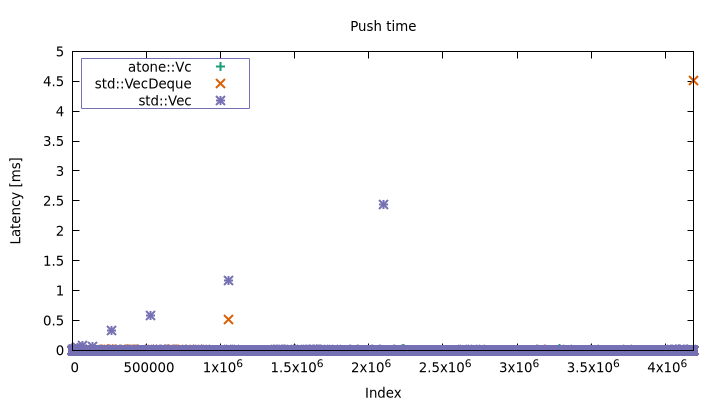A VecDeque (and Vec) variant that spreads resize load across pushes.
Most vector-like implementations, such as Vec and VecDeque, must
occasionally "resize" the backing memory for the vector as the number of
elements grows. This means allocating a new vector (usually of twice the
size), and moving all the elements from the old vector to the new one.
As your vector gets larger, this process takes longer and longer.
For most applications, this behavior is fine — if some very small number of pushes take longer than others, the application won't even notice. And if the vector is relatively small anyway, even those "slow" pushes are quite fast. Similarly, if your vector grow for a while, and then stops growing, the "steady state" of your application won't see any resizing pauses at all.
Where resizing becomes a problem is in applications that use vectors to keep ever-growing state where tail latency is important. At large scale, it is simply not okay for one push to take 30 milliseconds when most take double-digit nanoseconds. Worse yet, these resize pauses can compound to create significant spikes in tail latency.
This crate implements a technique referred to as "incremental resizing", in contrast to the common "all-at-once" approached outlined above. At its core, the idea is pretty simple: instead of moving all the elements to the resized vector immediately, move a couple each time a push happens. This spreads the cost of moving the elements so that each push becomes a little slower until the resize has finished, instead of one push becoming a lot slower.
This approach isn't free, however. While the resize is going on, the old vector must be kept around (so memory isn't reclaimed immediately), and iterators and other vector-wide operations must access both vectors, which makes them slower. Only once the resize completes is the old vector reclaimed and full performance restored.
To help you decide whether this implementation is right for you, here's a handy reference for how this implementation compares to the standard library vectors:
- Pushes all take approximately the same time. After a resize, they will be slower for a while, but only by a relatively small factor.
- Memory is not reclaimed immediately upon resize.
- Access operations are marginally slower as they must check two vectors.
- The incremental vector is slightly larger on the stack.
- The "efficiency" of the resize is slightly lower as the all-at-once resize moves the items from the small vector to the large one in batch, whereas the incremental does a series of pushes.
Also, since this crate must keep two vectors, it cannot guarantee that
the elements are stored in one contiguous chunk of memory. Since it must
move elements between then without losing their order, it is backed by
VecDeques, which means that this is the case even after the resize has
completed. For this reason, this crate presents an interface that
resembles VecDeque more so than Vec. Where possible though, it
provides Vec-like methods. If you need contiguous memory, there's no
good way to do incremental resizing without low-level memory mapping
magic that I'm aware of.
Benchmarks
There is a silly, but illustrative benchmark in benches/vroom.rs. It
just runs lots of pushes back-to-back, and measures how long each one
takes. The problem quickly becomes apparent:
$ cargo bench --bench vroom > vroom.dat
Vec max: 2.440556ms, mean: 25ns
VecDeque max: 4.512806ms, mean: 25ns
atone::Vc max: 25.789µs, mean: 26ns
You can see that the standard library implementations have some pretty
severe latency spikes. This is more readily visible through a timeline
latency plot (misc/vroom.plt):

Resizes happen less frequently as the vector grows, but they also take longer when they occur. With atone, those spikes are mostly gone.
A note on in-place resizing
Some memory allocators have an API for increasing the size of an
allocation in-place. This operation doesn't always succeed, in which
case it falls back to a regular allocation plus a memcpy, but when it
does, the resize is basically free. Vec and VecDeque are
occasionally able to take advantage of this kind of in-place resizing,
whereas atone::Vc is not.
In practice, you are unlikely to get in-place resizing for vectors that
fit the use-case for atone::Vc. If the running application continues
to allocate memory elsewhere, chances are something will get allocated
in the space on the heap after the current backing memory for the
vector, in which case in-place reallocation isn't possible.
Vec specifically also has a further optimization (I'm not sure what
it's called), in which it can perform in-place resizing even when the
allocation is surrounded on the heap. I assume that this involves some
memory remapping trickery. This only works on particular allocators
though (it does not work with jemalloc for example).
Implementation
atone is backed by two VecDeques. One is the "current" vector, and one
holds any leftovers from the last resize. Logically, the leftovers are
treated as the head of the vector, and the current vector is treated as
the tail. The "incremental" piece on push is then implemented by popping
elements from the leftovers and pushing them onto the front of the
current vector. It's this shifting, combined with the need to support
push, that made me go with VecDeque, since with a Vec, pushing to
the front would have to shift all the elements.
atone aims to stick as closely to Vec and VecDeque as it can, both
in terms of code and API. src/lib.rs is virtually
identical to src/liballoc/collections/vec_deque.rs in std (I
encourage you to diff them!).
Why "atone"?
We make the vector atone with more expensive pushes for the sin it committed by resizing..?
License
Licensed under either of
- Apache License, Version 2.0 (LICENSE-APACHE or http://www.apache.org/licenses/LICENSE-2.0)
- MIT license (LICENSE-MIT or http://opensource.org/licenses/MIT)
at your option.
Contribution
Unless you explicitly state otherwise, any contribution intentionally submitted for inclusion in the work by you, as defined in the Apache-2.0 license, shall be dual licensed as above, without any additional terms or conditions.

